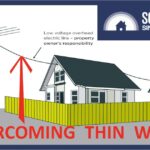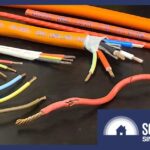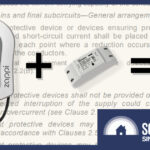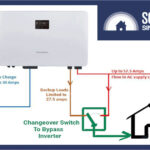Electrical Nightmares: The Terrifying Realities of Household Wiring
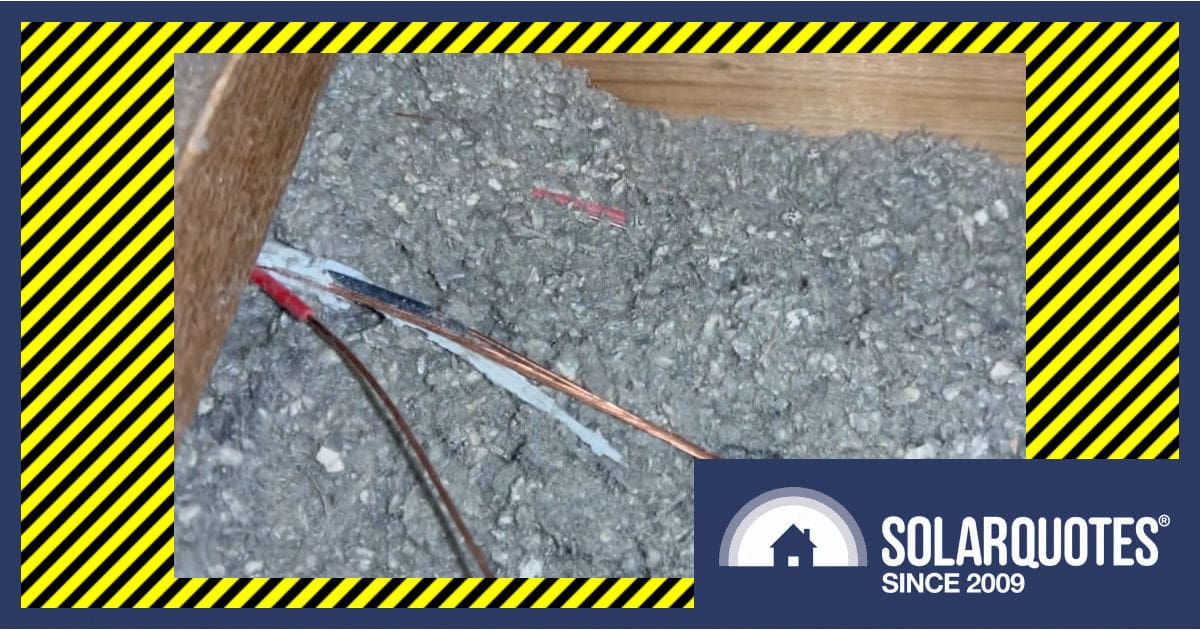
Hard to believe, but this shiny, stripped copper cable inside a house roof is the handiwork of birds!
Electricity is crucial in modern society, powering almost everything we use daily. In Australia, working with anything over 50 volts AC or 120 volts DC (ripple-free) requires a licensed electrician.
Sure, some folks see that as government overreach and featherbedding by the sparkies’ union. But there’s a good reason you don’t want your unlicensed cousin working on the high-voltage stuff at your home or office. Electricity can easily kill if mishandled.
This post hopes to highlight just how dangerous working on Australian homes can be.
There Are Exceptions
Electricians aren’t infallible. I recall an incident where an unidentified electrician accidentally cut off power to a construction site, leading to a chaotic situation where everyone suddenly had to walk buckets of concrete up the stairs . Without electricity, the materials lift was now out of action, and no electrician wants to bear the wrath of an angry concreter or have to buy them cartons of beer in compensation.
Don’t Begrudge Electrical Safety
When an electrician, or anyone else, turns up to work on your house, the last thing you want them to do is turn the power off. It’s terribly inconvenient, after all. The thing is that in many cases, it’s illegal for a worker to enter a confined space like your ceiling cavity, without first isolating the supply.
What’s more inconvenient than turning the telly and the lights off? Having the police, ambulance, fire service and SES turn up to tear your roof off, and extract a lifeless body.
That might sound like hyperbole, too, but it happens more often than many people would be comfortable knowing. In fact, 4% of work-related deaths are caused by contact with electricity, seven electrical workers don’t go home each year, and the nature of the work and demographics means they’re often young blokes with families.
This is also why – tempting as it may be – throwing an extension cord over the fence to solar power your neighbour’s garden shed is highly illegal. You can’t have more than one supply to a premises.
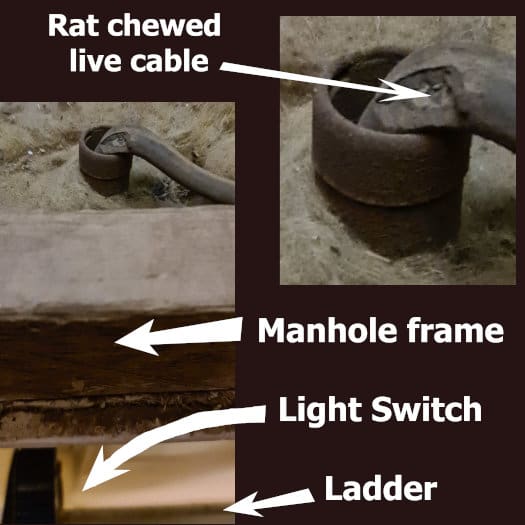
Right where you crawl through the manhole is a dumb place to put this metal conduit, but the rat-chewed insulation takes the cake.
New Houses Aren’t Immune
Residual current devices (RCDs) have been compulsory for years now, so modern houses are inherently safer due to “safety switches” being the default. Yet, this doesn’t rule out the risk of pests gnawing on your wiring, exposing live parts with a dangerous bite. The electrician who found the fault pictured below thought the damage was due to rats, but actually, it was birds that chewed this wiring clean. Thankfully, this house wasn’t burnt down in the process.
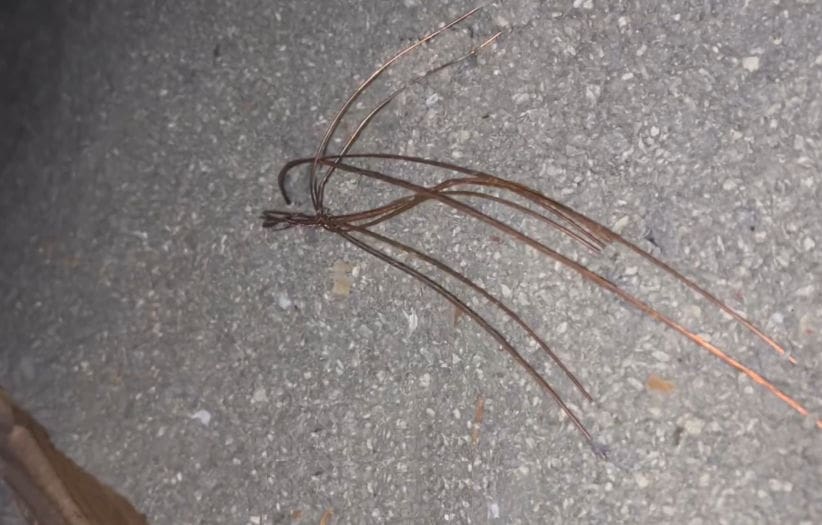
Loose fill blow-in insulation, yes; electrical insulation, NO! These lighting cables are totally bare.
I’ve gathered some images recently from a few electricians’ forums as well as a selection of connections that have tried to kill me personally in the last few years, but read on for some prime examples of why you should always check carefully when working around the house and bear in mind that not everyone follows the rules.
Old Houses Can Hide Great Dangers
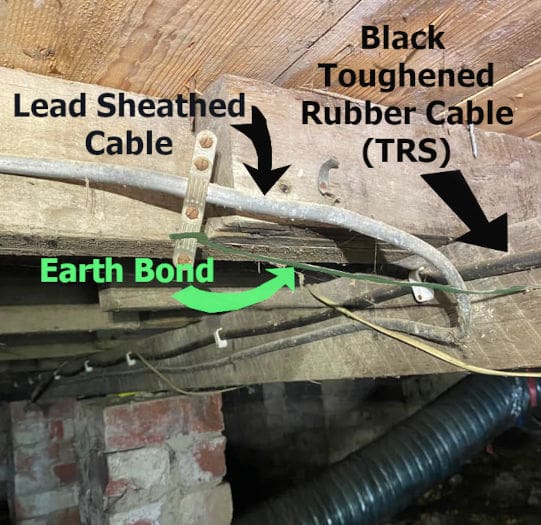
Lead sheath is very unusual to find but equally dangerous because nobody realises electrical cables ever came in flexible metal format.
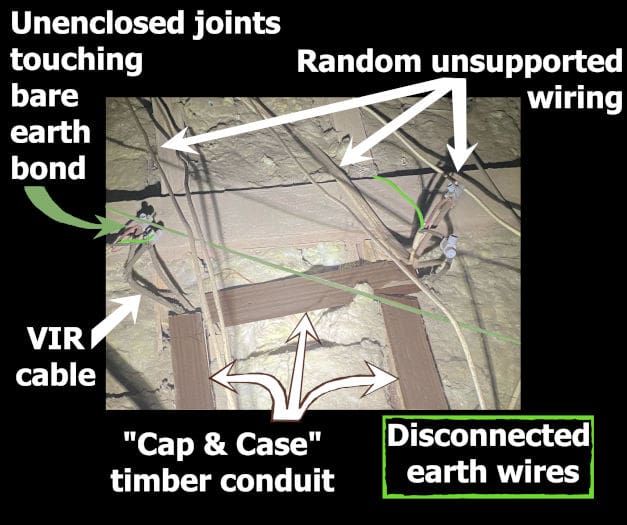
Yes, wood can be used as a conduit, too. Arguably not as dangerous as a metal conduit, I’ve seen this type of wiring still in service at what could be 100 years old.
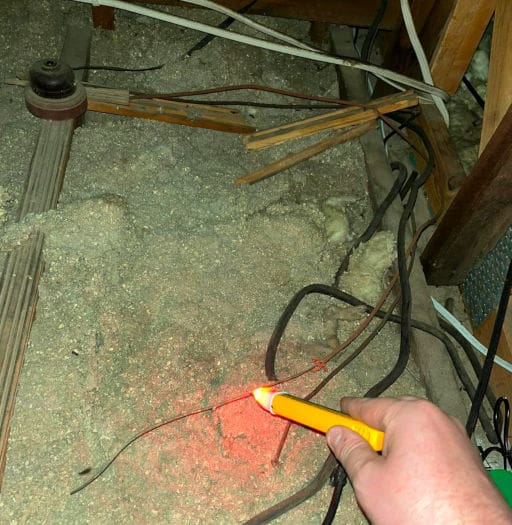
Never mind the new cables added over a broken wooden conduit(!) That red glow is a “volt stick”, which indicates that stripped bare VIR cable is laying there casually, exposed, open and LIVE.
Toughened Rubber Sheath (TRS)
TRS was common after WW2, and in many cases, it’s fine until it’s disturbed. However, because it becomes incredibly brittle, you don’t need much force to make it crumble and fall away like sugar from the side of your cocktail glass. The bare wires can give you a much worse headache though.
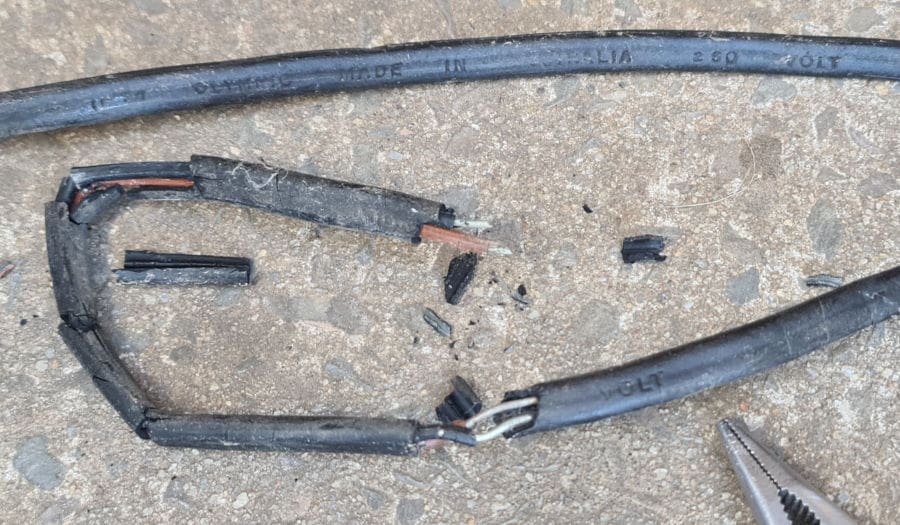
Olympic – Made In Australia – 250 Volt. This toughened rubber sheath cable was found in a house that had been “totally rewired” but the dodgey prick involved didn’t change all the wiring. It was my house and rest assured the bloke doesn’t work for me anymore.
Vulcanised Indian Rubber
What is arguably more dangerous is Vulcanised Indian Rubber cable, which looks like a shoelace. It has a woven cotton sheath, often protected inside a black-painted steel conduit. Once again, the rubber insulation becomes brittle and crumbly because it’s much the same as TRS, rubber insulation that was once soft, but VIR doesn’t have the smooth black sheath.
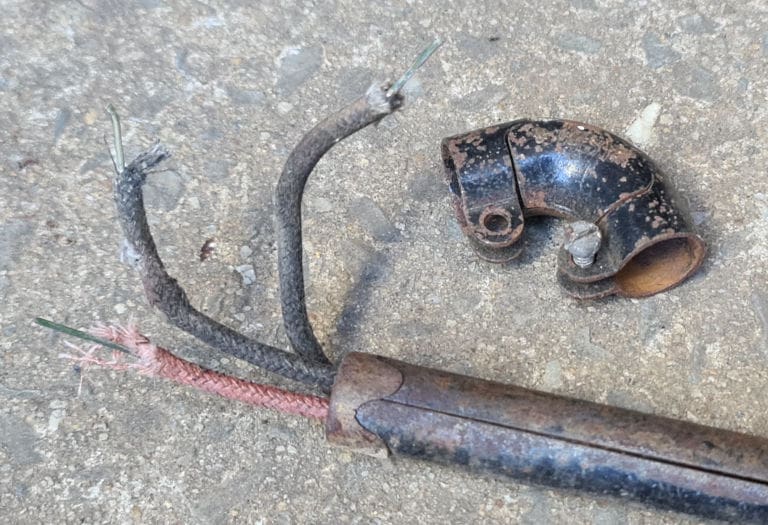
Fun Fact. The brand name “Clipsal” was derived from fittings like this elbow that would work with many different brands & sizes of pre-standard conduit. It was a range that “clips all’ types of conduit together.
What VIR does have is a death trap.
Wiring systems in old houses rely on the split seam steel conduit to form the protective earth bond, only for socket outlets in wet areas like laundries and kitchens. Light fittings, the mantel radio and your bedroom, didn’t have an earth at all. (Did the bedroom even have a PowerPoint?)
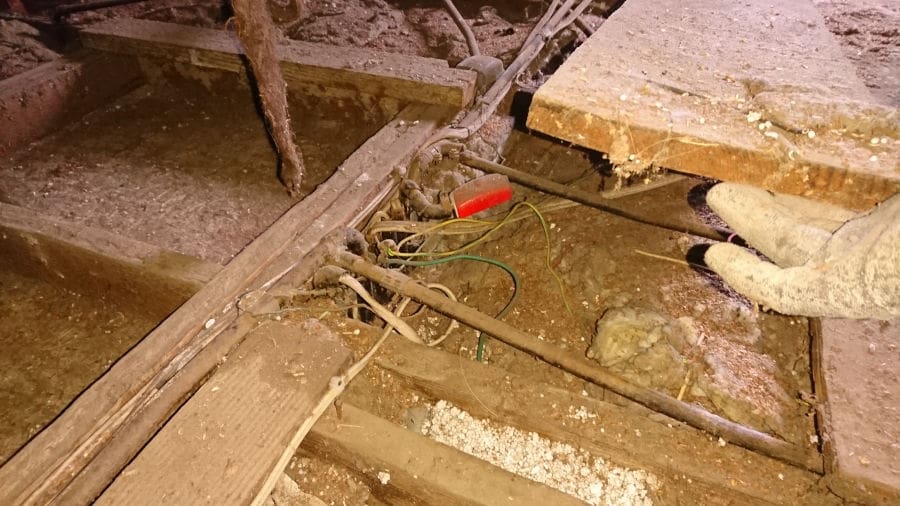
Crawl board I had just lifted off reveals the mess of wiring right near the manhole
The problem with split steel conduit is that if someone steps on it and separates the parts, the earth path is broken. Worse still, it’s not very strong. The act of stepping on the conduit can easily cause it to cut the old brittle cables inside like a scissor, leaving a live steel pipe in the roof for you to place your hand on, or a live metal appliance in the room that is fed by this now compromised circuit.
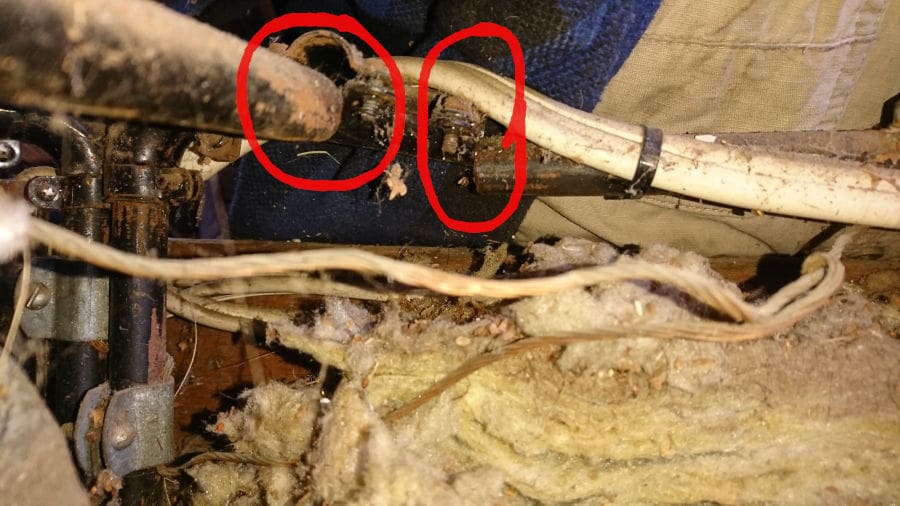
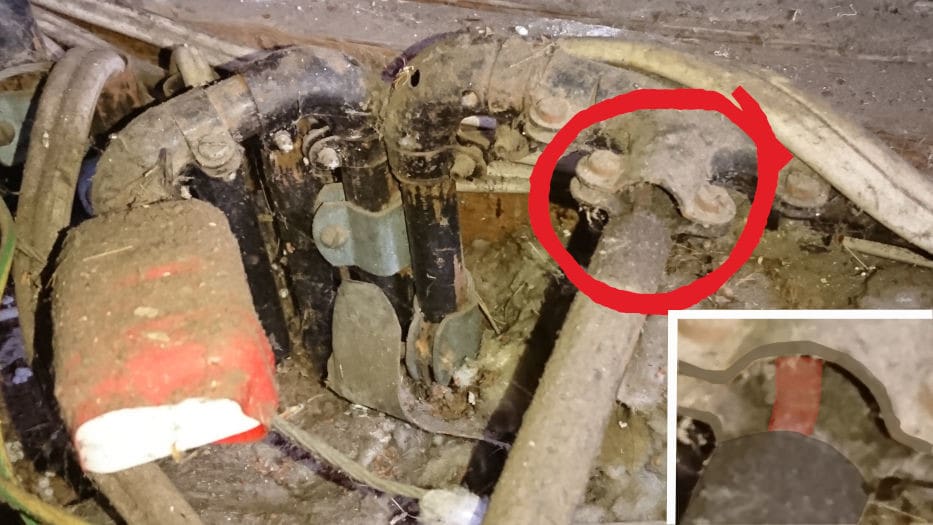
Live cable with a steel conduit resting on it. This is death on a stick I managed to avoid.
This particular job was a pretty complex solar layout, so there were four separate arrays to run HD solar conduit and wiring through the roof. We managed not to damage anything, but the owner was disappointed that her nephew, a supposed electrician, hadn’t rewired the place like he said he had.
I was disappointed that this all has to be replaced. The original installation was obviously well done by someone who cared about their work, but 70-odd years have taken its toll.
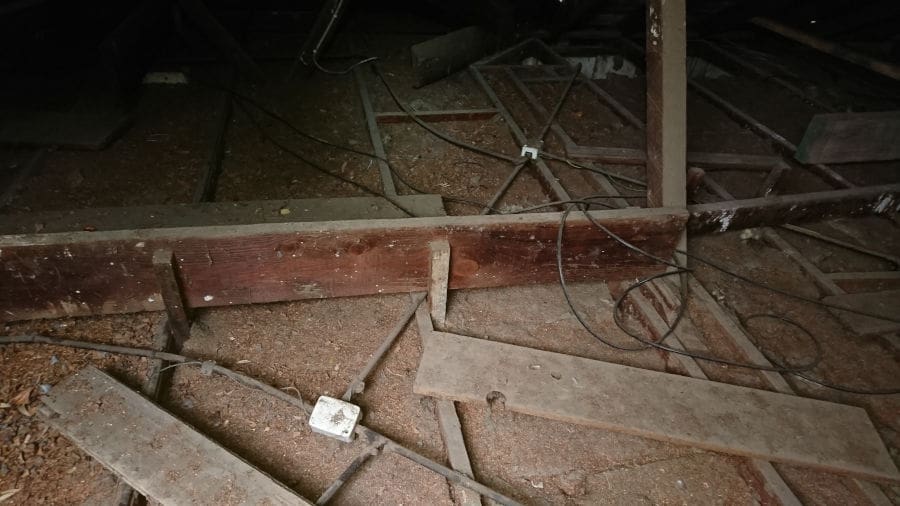
Plastic junction boxes on steel conduit means someone has been fiddling. Nothing good is going to come out of this.
In Western Australia there are laws meaning that if an electrician finds these rubber insulated cables in your house, they’re obliged to report them or replace them.
Be Careful Out There
Many people think it can’t happen to them, and they take some risks that aren’t necessary. I know because I was one of those who would tell the customers we’ll only have the power off for a few minutes. I urge people to recognize their own power in ensuring safety, by taking a proactive approach. Tell your electrician you don’t want them in the roof when the power is on, and take an interest in seeing they show you how to turn it off yourself.
One of the best work health and safety experiences I ever had was a high-rise building manager. Knowing the weather would be diabolically hot, he sought out and printed off our solar company WHS policy and stuck it on the roof access door. Then he watched as the temperature rose 10 degrees in an hour and hounded us off his roof once it hit 38°C.
In another post, I’ll look at yet more dodgy wiring and explain how some people get away with being unlicensed electricians.
Original Source: https://www.solarquotes.com.au/blog/electrical-nightmares-the-terrifying-realities-of-household-wiring/




